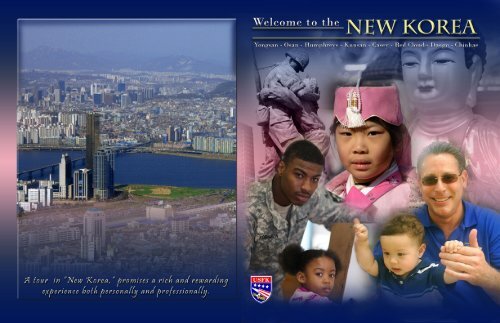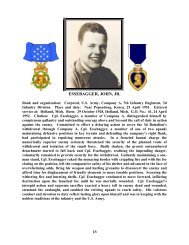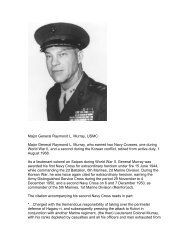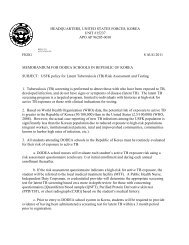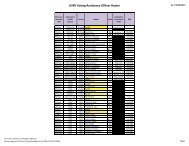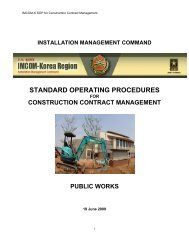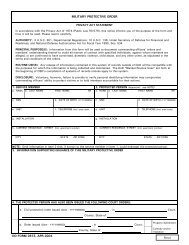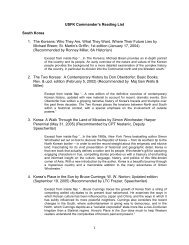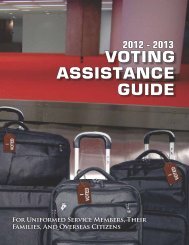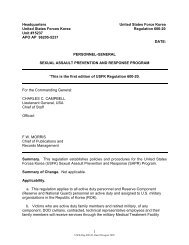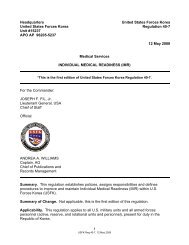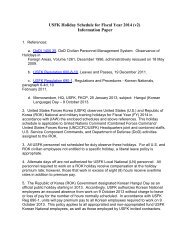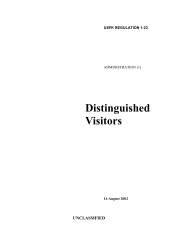Create successful ePaper yourself
Turn your PDF publications into a flip-book with our unique Google optimized e-Paper software.
The Republic of <strong>Korea</strong>, also known as South <strong>Korea</strong>, is a peninsular country the<br />
size of Indiana located between China, Japan and Russia. It is on the same<br />
latitude as Washington D.C. and has four distinct seasons. Almost half of the 49<br />
million citizens live in Seoul or the Seoul suburbs and <strong>Korea</strong>ns are one of the most<br />
ethnically and linguistically homogenous groups in the world.<br />
These facts alone cannot describe the spectacular mix of ancient traditions<br />
and modern lifestyles in the Republic of <strong>Korea</strong>.<br />
This country has maintained its distinct cultural identity, even as it<br />
became fully modernized with the 13th largest economy in the<br />
world.While serving in <strong>Korea</strong>, you will have the opportunity to<br />
visit historic palaces, shop at bustling markets and attend unique<br />
<strong>Korea</strong>n cultural festivals<br />
With superior schools, first class youth and child care services, and extensive military<br />
installation support facilities, life in <strong>Korea</strong> combines “American comforts”<br />
with the exotic benefits of living in a foreign country.<br />
The duality of <strong>Korea</strong> and the <strong>Korea</strong>n people make it a fascinating<br />
country to explore. The Republic of <strong>Korea</strong> changes so rapidly that<br />
unless you have visited recently, you might be surprised at what you<br />
find.<br />
Fast Facts<br />
President: Lee, Myung-Bak<br />
Currency: Won<br />
Language: <strong>Korea</strong>n (but English is taught in most schools)<br />
Written language: Hangul<br />
Largest Cities: Seoul, Busan, Daegu and Inchon<br />
Topography: 70% mountainous<br />
Literacy Rate: 98% (one of the highest in the world)<br />
National Bird: Magpie<br />
National Flower: Rose of Sharon
Military installations have support facilities for almost any errands:<br />
post office, AAFES PX/BX, Commissary, dry cleaners, and gas<br />
station. Family-orientated establishments include movie theaters<br />
with free first-run movies, bowling alleys, golf courses, libraries,<br />
hobby centers, self-help facilities, gyms, pools, and thrift stores.<br />
Plus, there are many restaurants and fast food establishments<br />
on military installations that include Baskin Robbins, Taco Bell,<br />
Subway, Starbucks, Pizza Hut, Burger King, Popeye’s, Black Angus<br />
and Chili’s. Cities in <strong>Korea</strong> offer many American resturants such as<br />
McDonald’s, Domino’s, Papa Johns, Outback, KFC and Hard Rock Café.<br />
There are many clubs and associations that family members can participate in, such as the American Forces’<br />
Spouses’ Club, Air Force/Navy/Marine Spouses’ Groups, <strong>New</strong> Parent Support programs and numerous<br />
volunteer programs. In addition, children and teenagers can participate in many programs, such as Boy or Girl<br />
Scouts, the Seoul Computer Club, and many school clubs.<br />
Family oriented facilities throughout installations in<br />
<strong>Korea</strong> offer game rooms with pool tables, darts, table<br />
tennis and foosball. Various events and competitions are<br />
held throughout the year. Some facilities feature Cyber<br />
Cafés, craft stores and Trophy Shops. For those with<br />
more creative outlets, musical instruments and sound<br />
rooms are available. Some military community centers<br />
host birthday parties, while others include small food<br />
courts.<br />
There are Arts & Crafts Centers located on six military<br />
installations in <strong>Korea</strong>, which provide a variety of leisure<br />
activities for both the amateur and the experienced. Programs<br />
include photography, matting and framing, drawing, painting,<br />
watercolor, oil painting, woodworking, art metal and jewelry, pottery,<br />
ceramics, fibers, decor and special crafts, sculpture and 3-D design<br />
(programs vary at each Arts & Crafts Center).<br />
There are also shows, such as musicals, comedy<br />
tours and concerts, such as Ne-Yo, Billy Joel,<br />
Young Joc, Yolanda Adams, Joe Holiday, and Edwin<br />
McCain that have toured throughout the peninsula.<br />
In addition, other venues have visited military<br />
installations specifically for service members and their<br />
families which include the Globetrotters and the Dallas<br />
Cowboy Cheerleaders.<br />
Military installations hold traditional American celebrations and functions<br />
throughout the year to help bring a sense of home to service members and<br />
their families. Most military installations hold parties for <strong>New</strong> Year’s,<br />
Valentine’s Day, St. Patrick’s Day, Easter, 4 th of July, Thanksgiving and<br />
Christmas.<br />
A major family friendly program is the Good Neighbor Program, which<br />
supports a successful Republic of <strong>Korea</strong> and United States relationship.<br />
Stories abound about friendships kindled, which often evolve into<br />
lifelong friendship of letters, email and phone calls. In addition, the<br />
program strengthens the ROK-US Alliance through comprehensive<br />
programs that actively engage the local community, government, media,<br />
business, university, school and military in order to provide a public<br />
understanding and appreciation of our mission on the <strong>Korea</strong>n Peninsula.<br />
Volunteering in the community is just one way that family members<br />
participate in the Good Neigbor Program. Many commands have long term<br />
relationships with local orphanages. Groups organize hikes to pick up trash along<br />
scenic mountain trails, river walks and beaches. Military installations also host English Camps where <strong>Korea</strong>n<br />
students stay with military families to improve their language skills. Individuals can volunteer at local vets,<br />
Red Cross and the USO.<br />
<strong>Korea</strong> is the most connected country in the world! High-speed Internet<br />
service is readily available. Phone plans with unlimited calls to the<br />
United States are also available as separate or package deals to<br />
help you stay in contact with family and friends.<br />
While any job can be demanding, scheduled holidays allow<br />
service members and their families time to recharge. U.S.<br />
Forces <strong>Korea</strong> often schedules Peninsula wide “training<br />
holidays” that correspond to government holidays,<br />
effectively turning a three day weekend into a four day<br />
weekend. The longer breaks allow service members<br />
time to explore sites in the Republic of <strong>Korea</strong>, travel<br />
to nearby countries, or just enjoy time at home.<br />
The Republic of <strong>Korea</strong> has a very low crime rate<br />
and most places are safe to travel any time, day or<br />
night. Illegal drugs and violent crime are practically<br />
non-existent, and even the police do not carry guns.
The Department of Defense Dependent Schools <strong>Korea</strong> (DoDDS-K) operates nine schools on the <strong>Korea</strong>n<br />
peninsula:<br />
USAG-Yongsan in Seoul<br />
Seoul American Elementary School provides education to students in grades pre-kindergarten thru 5th.<br />
Seoul American Middle School provides education to students in grades 6th thru 8th..<br />
Seoul American High School provides education to students in grades 9th thru 12th.<br />
USAG-Humphreys in nearby Pyongtaek City<br />
Humphreys American School provides education to students in grades kindergarten thru 8th.<br />
Osan Air Base in Songtan, Pyongtaek City<br />
Osan American Elementary School provides education to students in grades kindergarten thru 5th.<br />
Osan American Middle School provides education to students in grades 6th thru 8th.<br />
Osan American High School provides education to students in grades 9th thru 12th.<br />
Camp George in Daegu<br />
Daegu American School is a unit school providing education to students in grades kindergarten thru 12th.<br />
U.S. Navy Fleet Activities Chinhae<br />
C.T. Joy Elementary School provides education to students in grades kindergarten thru 8th.<br />
Department of Defense Dependent Schools-<strong>Korea</strong> really cares about meeting the needs of all students and<br />
does everything possible to ensure that no child is disadvantaged by an assignment in <strong>Korea</strong>.<br />
High Test Scores: Scores of high school students participating in the Advanced Placement tests for possible<br />
college credit are well above the national average of other high<br />
school students. The Terra Nova Multiple Assessment is a battery<br />
of subtests designed to measure content-area achievement and is<br />
administered to all Department of Defense Education Activity<br />
(DoDEA) students in Grades 3 through 11. DoDDS-K students<br />
consistently outperform their stateside and DoDEA peers. For<br />
the past three years, students scored between the 60 th and 75 th<br />
percentile in the areas of Reading, Language, Mathematics,<br />
Science and Social Studies. DoDDS-K high school<br />
juniors and seniors scored higher on the SAT<br />
(Scholastic Aptitude Test) than the national average in<br />
mathematics and writing for the past three years.<br />
Graduation Rates: In 2008, 98% of all high<br />
school seniors attending a DoDDS-<strong>Korea</strong> high<br />
school graduated.<br />
Scholarships: In 2008, scholarships totaling $6,025,000 were awarded to DoDDS-K students from a<br />
combination of State, local military/ROTC, and grant sources. Equally impressive, 62 JROTC cadets received<br />
appointments to some of the most prestigious military academies in the United States.<br />
Best Education Possible: DoDDS-K offers research-driven support services to students of all ages, from<br />
pre-kindergarten to high school in the form of more than 17 distinct programs. Advancement Via Individual<br />
Determination (AVID), READ 180, and tutors for math are specialized programs supported by full-time<br />
instructors and proven methodologies that have resulted in more than 97% of DoDDS-K students having a<br />
valid and documented post secondary plan for graduation. No matter the age of your kids, they will receive<br />
the best possible education.<br />
Military Education Center offers a wide variety of college programs for service members and their<br />
families to promote lifelong learning opportunities, and to contribute to professional growth, career<br />
enhancement and self-development. Counselors are available to help service members and their families apply<br />
their educaction benefits. Tuition assistance and the Montgomery GI Bill are common programs, but other<br />
financial assistance programs and scholoarships are available.<br />
Classroom Education Programs (vary by location):<br />
Associate degree programs in criminal justice, child development, general studies, legal services and computer<br />
studies.<br />
Bachelor and Associate programs in general studies, Asian studies, computer studies, information system management,<br />
psychology, sociology, business management, business and criminology.<br />
Masters in Public Administration, Masters in Education and Business Administration and Masters in International<br />
Relations.<br />
When a service member or their family is unable to participate in classroom education programs, or a desired<br />
course is not available locaclly, it may be appropriate to select<br />
a distance learning course or degree program. Many<br />
accredited institutions offer some form of distance<br />
learning and education centers can assist in the process.<br />
Testing Programs:<br />
Academic testing is another service provided by<br />
Education Centers. Common academic tests like<br />
the SAT, ACT, GRE and PRAXIS are given in a<br />
group setting. If your academic program requires<br />
proctored exams, students can make individual<br />
appointments.
Hangul, the <strong>Korea</strong>n alphabet, invented in the 15 th Century, is one of the many unique <strong>Korea</strong>n inventions.<br />
The phonetic alphabet, based on syllable groups, has only 14 consonants and 10 vowels. Today, <strong>Korea</strong><br />
has one of the highest literacy rates in the world, over 98%. Sometimes translations to English are imperfect<br />
since one <strong>Korea</strong>n consonant represents two English consonants : r/l, b/p, g/k, ch/j and d/t. In <strong>Korea</strong>n<br />
conversations, “yes” does not always constitute agreement. It simply means that your question has been heard<br />
and acknowledged. It is best to ask questions that cannot be answered with “yes” or “no.”<br />
Bowing is a traditional <strong>Korea</strong>n greeting, although men have adopted the custom of shaking hands. To<br />
show respect when shaking hands, support your right forearm with your left hand. Business cards should be<br />
exchanged with both hands, and the receiver should take a few moments to read the other person’s card. It is<br />
impolite to write on another person’s card or put it immediately in your pocket because the card is considered<br />
an extension of the person. It is acceptable for you to write more information on your own business card.<br />
It is appropriate to bring a gift when you visit someone’s home. The receiver usually politely refuses so as not<br />
to seem greedy and the giver must politely insist that they take the gift. Traditionally the gift is not unwrapped<br />
in front of the giver to avoid embarrassment on both sides if the gift is not liked. Sometimes the giver will<br />
follow the Western tradition and insist that the gift be opened immediately.<br />
<strong>Korea</strong>n names consist of a family name (one syllable) and given name (two<br />
syllables). The family name comes first. When they get married, women<br />
keep their family name, but children are usually given their father’s family<br />
name.<br />
<strong>Korea</strong>ns are considered one year old when they are born, so they will<br />
often differentiate “<strong>Korea</strong>n age” or “Western age” when asked. It is<br />
traditional to have a party for babies 100 days after they are born.<br />
In the past, if a child lived for 100 days their chances to survive<br />
until adulthood were good. Modern medicine has reduced<br />
the infant mortality rate, but the 100 day milestone is still<br />
celebrated with rice cakes and other delicacies.<br />
Personal relationships are important in the <strong>Korea</strong>n culture.<br />
Pleasantries are usually exchanged before business.<br />
Colleagues often eat dinner together and socialize after<br />
work. You are expected to remove your shoes when entering<br />
a person’s home, temples and in restaurants where you sit at<br />
low tables on raised floors.<br />
Soccer and baseball are in close competition for <strong>Korea</strong>’s number one team sport, and there are several<br />
popular individual sports. It is also possible to find running clubs, hockey leagues, rugby teams and<br />
other niche groups formed by international citizens and <strong>Korea</strong>ns with common interests.<br />
Baseball:<br />
Baseball is extremely popular, especially after the ROK team won gold in the 2008 Summer Olympics and<br />
came in second in the 2009 World Baseball Classic. There are currently eight teams in the <strong>Korea</strong>n Baseball<br />
Organization, established in 1982, that play throughout the season and in the post-season <strong>Korea</strong>n Series.<br />
Soccer:<br />
Soccer received a huge boost in popularity when the <strong>Korea</strong>n team came in fourth at the 2002 Federation<br />
Internationale de Football Association (FIFA) World Cup championships. The national soccer league has<br />
15 teams that play each other twice per season. The World Cup stadium in Seoul, which seats 64,000, was<br />
built for the 2002 FIFA games.<br />
Hiking & Skiing:<br />
Hiking is a staple in the Republic of <strong>Korea</strong>, where 70% of the land is mountainous. Even in the middle of<br />
Seoul there is Namsan Park, which has the famous Seoul Tower sitting on top. Plenty of hills means that<br />
there are plenty of places to ski. There are 12 major ski resorts in <strong>Korea</strong>, and most have the ability to make<br />
artificial snow. <strong>Korea</strong> hosted the World Cup Ski Competition in 1998 and the 1999 Winter Asian Games.<br />
Golf:<br />
Several of the ski resorts are co-located with golf courses so the resorts are open<br />
year round. Jeju-Do, an island south of the <strong>Korea</strong>n Peninsula, has quite a<br />
few golf courses. Jeju-Do is also a common honeymoon destination,<br />
famous for its beaches, snorkeling and scuba diving, its oranges, its<br />
warmer weather and Mount Halla, the extinct volcano that created<br />
the island.<br />
Taekwondo:<br />
Four million <strong>Korea</strong>ns practice taekwondo and it is taught to all<br />
<strong>Korea</strong>n military personnel. This martial art is popular among<br />
both men and women and concentrates on punching, kicking,<br />
blocking and self-discipline. Shouting while you practice is<br />
said to relieve stress and makes demonstrations impressive.<br />
Tipping is not expected at restaurants and can be viewed as<br />
an insult, implying that a tip is required for good service.<br />
Some restaurants add a ~15% service charge and tax to the<br />
listed price. If dining on a military installation, tip as you<br />
would in the United States.
<strong>Korea</strong> has a wide variety of shopping venues. Open-air markets have street vendors with negotiable<br />
prices. <strong>Korea</strong> also has high-end malls with movie theaters, restaurants, aquariums and arcades that are so<br />
Western it is easy to forget that you are in <strong>Korea</strong>.<br />
<strong>Korea</strong>n Items:<br />
“Mink” blankets, leather goods, paper fans, traditional carved wooden masks and traditional <strong>Korea</strong>n clothes<br />
are common purchases. In addition, don’t forget to put these on your shopping list:<br />
Ginseng root, a common ingredient in Oriental medicine, can be purchased in powders, teas, tablets, and<br />
liquid extract. It is thought to increase strength, rejuvenate one’s body and skin and prevents a number of<br />
illnesses. For more decorative shopping, Kimchi pots, big brown-ware crocks with lids, are popular souvenirs<br />
and sizes range from a small coffee mug to four-feet tall. Another item is celadon pottery.<br />
Original celadon pottery was made in the 12 th century and is only displayed in <strong>Korea</strong>n museums, but modern<br />
celadon vases are widely available. If you would like to pick up some gemstones, such as amethyst, topaz<br />
and jadeite, are mined in <strong>Korea</strong>, but jadeite is often used for decorative carvings rather than jewelry. Some<br />
jewelers will make custom pieces.<br />
Tailors and Seamstresses:<br />
It is easy to find tailors or seamstress in <strong>Korea</strong>. The easiest<br />
way to order an item is to have a picture of what<br />
you want made. You will be able to pick the<br />
fabric from samples at the shop. A minimum<br />
of three visits is advised: 1) for initial<br />
measurement and order, 2) a<br />
fitting and 3) the final fitting<br />
and, if you are satisfied,<br />
purchase.<br />
Specialty Districts:<br />
Small <strong>Korea</strong>n shops selling similar products are often grouped together, which results in specialty districts,<br />
such as “Electronics Market,” “The Fabric Market,” “Toy Alley,” “The Flower Market,” “The Fish Market,”<br />
and “The International Market.”<br />
Some of the best deals are found in large shopping districts that span several blocks where negotiating for<br />
the best prices is the standard practice. The language barrier will not hinder your bargaining since most<br />
shopkeepers keep a calculator handy to help communicate. These large shopping markets can be crowded<br />
with other shoppers and vendors set up in every available space, which only adds to the experience.<br />
Department Stores, Chain Stores and Malls:<br />
You can find plenty of stores with fixed prices.<br />
COSTCO <strong>Korea</strong> is the same as COSTCO in the United States. Members pay an annual fee, but can purchase<br />
items in bulk.<br />
E-Mart and Lotte Department stores are chain stores that often have parking. They have a grocery section<br />
and an everything-else section with clothes, shoes, gym equipment, cosmetics, toys, dishes, bedding and<br />
books. These stores are often crowded on the weekends when most <strong>Korea</strong>ns shop, and the grocery section<br />
often offers free samples.<br />
Larger shopping complexes with small shops, food courts and movie theaters, equivalent<br />
to multi-story America malls, are also prevalent through-out <strong>Korea</strong>.<br />
Money:<br />
Some vendors accept either U.S. dollars or <strong>Korea</strong>n Won. Savvy shoppers<br />
know the current exchange rate and will be able to determine which<br />
currency they should use to get the best price.<br />
<strong>Korea</strong> is a cash based society. The largest <strong>Korea</strong>n bill is 50,000 Won,<br />
roughly $50 depending on the exchange rate. It is normal to carry around<br />
large amounts of cash, but never fear, <strong>Korea</strong> is very safe country. Most places<br />
also accept credit cards.<br />
Internet:<br />
The Internet is a shopping alternative if you cannot find what you<br />
want on military installations or in a <strong>Korea</strong>n market. The<br />
average mailing time to an APO AP address is 7-10 days<br />
depending on the CONUS origin.
Broadway Shows, musicals, symphonies, operas, museum<br />
exhibits, concerts; the Republic of <strong>Korea</strong> has it all. The<br />
rotating nature of the performances helps ensure that there<br />
is always something new and exciting to see.<br />
Itaewon, often referred to as the foreigner district, is<br />
Seoul’s largest multicultural district. Itaewon is known<br />
for its international cuisine and shopping. The area<br />
is a common destination for a variety of international<br />
citizens, not just U.S. service members.<br />
Even when “nothing special” is going on<br />
there are water parks, indoor amusement<br />
parks, skiing and snowboarding, hot springs,<br />
aquariums, rafting, hiking, biking, zoos and parks to explore.<br />
Getting around Seoul and the rest of <strong>Korea</strong> is quite simple. Seoul’s extensive bus and<br />
metro subway system are convenient ways to travel. Taxis are<br />
also available 24 hours a day and are not expensive. When<br />
traveling throughout <strong>Korea</strong>, a trip from Seoul to Pusan is<br />
only three hours on the <strong>Korea</strong>n Express Train (KTX), or<br />
“bullet train.” The KTX can reach speeds up to 300 kph.<br />
Seoul, the capital, is the largest city in the Republic of<br />
<strong>Korea</strong> and is often compared to <strong>New</strong> York or London<br />
because of the night life and cultural activities. Busan,<br />
the second largest city in the Republic of <strong>Korea</strong>, hosts<br />
an annual international film festival on <strong>Korea</strong>’s most popular<br />
beach, Haeundae Beach in Busan. Gyeongju was the capital of<br />
the Silla Kingdom and has many well preserved historical sites.<br />
Chinhae is normally a quiet little town except for when the Cherry<br />
Blossom Festival is held each spring. At the Boryeong Mud Festival<br />
people of all ages play in mud with natural minerals that is said to<br />
revitalize your skin. Mount Sorak is a popular fall destination when<br />
the leaves change color. Each fall Gwangju has a Kimchi Festival that<br />
is, quite obviously, all about kimchi.<br />
Public Holidays in the Republic of <strong>Korea</strong><br />
Solar <strong>New</strong> Year (1st of January) - Same as the United States.<br />
Lunar <strong>New</strong> Year (1st day of the 1st lunar month) - <strong>Korea</strong>ns visit their families, eat special food (tteok guk<br />
[rice cake soup] and mandu guk [dumpling soup]) and play traditional games or fly kites.<br />
Independence Movement Day (1st of March) - <strong>Korea</strong>n uprising from Japanese rule in 1919.<br />
Children’s Day (5th of May) - children have the day off and their parents take them to amusement parks,<br />
zoos or other places of interest.<br />
Buddha’s birthday (8th day of 4th lunar month) - Ceremonies are held in Buddhist temples all over <strong>Korea</strong><br />
and colorful lanterns are hung in the temples’ courtyards.<br />
Memorial Day (6th of June) - is dedicated to those people who died for their country. A special ceremony is<br />
held at the National Cemetery in Seoul.<br />
Liberation Day (15th of August) - Commemorates the day when Japan surrendered to the allied forces and<br />
<strong>Korea</strong> was liberated in 1945.<br />
Chuseok (15th day of 8th lunar month) - Chuseok, known as the <strong>Korea</strong>n Thanksgiving, celebrates the<br />
harvest and is a thanksgiving for the earth’s products. During this holiday <strong>Korea</strong>ns visit their ancestral homes<br />
and share traditional foods.<br />
Foundation Day (3rd of October) - is a public holiday that commemorates the foundation of the<br />
<strong>Korea</strong>n nation in 2333 BC, by the legendary god-king Dangun. A ceremony is performed on top of<br />
Mount Manisan in the Ganghwado province.<br />
Christmas Day (25th of December) - Christian Holiday.<br />
<strong>Korea</strong> has special events, from local festivals to national<br />
celebrations, that service members and their families can<br />
enjoy year round.
Kimchi and rice are staples of every traditional <strong>Korea</strong>n meal. Spicy<br />
fermented cabbage is the most popular form of kimchi, but any<br />
seasoned vegetable preserved by fermentation is considered kimchi.<br />
Cabbage, radish, cucumber, and turnip are the most common<br />
types of kimchi, but mushroom, eggplant, leeks, gourd, bamboo,<br />
soybean leaf and Indian mustard are also used. Kimchi can<br />
range from mild to spicy depending on the recipe. Also, most<br />
traditional <strong>Korea</strong>n restaurants offer unlimited side dishes at no<br />
extra cost; they are considered part of the meal. The side dishes, or<br />
banchon, can include different types of kimchi, tofu, egg soufflé and<br />
soup.<br />
Red Pepper Paste or Powder<br />
Red pepper paste or powder is commonly used to make kimchi and other <strong>Korea</strong>n food spicy. It can often be<br />
omitted or halved in recipes to make the dishes milder. If you need more “heat,” it is often a condiment on the<br />
table so diners can flavor their dish to taste.<br />
Desserts<br />
Sweet desserts are not common after a meal, but fruit, tea or coffees are sometimes served. Small bite-size<br />
rice cakes, made from glutinous rice flour, are prepared for special occasions and holidays. Rice cakes can be<br />
simple or very elaborate, and vary in color. Nuts, dried fruit, seeds, red beans and sweetened sesame seeds can<br />
be inside or used to decorate the outside of the cakes.<br />
Drinks<br />
In some restaurants, patrons get their own water (mul) from a central water cooler using cups stored in a<br />
sanitizer nearby. <strong>Korea</strong>n drinking cups and glasses only hold 6-8 ounces. Common after dinner teas include<br />
green, barley, ginseng, berry and citron. Coffee is often made using individual serving size packets with cream<br />
and sugar included, and decaf is rare.<br />
Alcohol<br />
Soju is a clear distilled liquor; similar to sake or<br />
vodka, but with a slightly sweet taste. Soju is<br />
about 20% alcohol by volume and is often<br />
served with <strong>Korea</strong>n meals. The <strong>Korea</strong>n<br />
custom is to pour drinks for others using<br />
both hands, and then let someone pour<br />
your drink, so that you never pour your own<br />
drink when sharing a meal. Because it is<br />
inexpensive and can be purchased almost<br />
anywhere, soju is one of the most popular<br />
alcoholic beverages in <strong>Korea</strong>. Beer is also<br />
commonly served with meals.<br />
Learning the names of a few common dishes can help you<br />
navigate almost any <strong>Korea</strong>n menu:<br />
Broiled or Grilled Foods<br />
Bulgogi - thinly sliced pieces of marinated beef grilled in a pan<br />
Dak-gui - grilled chicken<br />
Kimchi<br />
Ggakdugi - chopped radish kimchi<br />
Oi Kimchi - cumcumber kimchi<br />
Baek Kimchi - white cabbage kimchi<br />
Meats and Poultry<br />
Dalk - chicken<br />
Bulgogi - thinly sliced pieces of marinated beef grilled in a pan<br />
Galbi - short beef ribs<br />
Samgyetang - ginseng chicken soup<br />
Samgyeopsal - a fatty bacon-type pork grilled over hot coals at your table<br />
Soups and Stews<br />
Kimchi jjiggae - kimchi stew<br />
Galbi jjim - short rib stew<br />
Bosin tang - dog soup<br />
*** Please note that dog is more expensive than other meats and only<br />
served at speciality resturants, so it is never served accidently.<br />
Noodles and Noodle Dishes<br />
Naengmyeon - cold noodles in soup<br />
Japchae - mixed vegetables with noodles<br />
Ramyeon - Ramon noodles<br />
Rice and Rice Dishes<br />
Bibimbap - rice with mixed vegatables<br />
Gimbap - rice wrapped, similar to sushi roles, except all the<br />
meat is cooked<br />
Dolsot bibimap - bibimbap served in a hot stone bowl/crock<br />
Bokgeumbap - fried rice<br />
Street Food<br />
Mandu - dumplings that can be fried, boiled or steamed<br />
Hotteok - pita bread filled with cinnamon and honey
Located in the middle of Northeast Asia, the Republic of <strong>Korea</strong> is a convenient starting point for travel.<br />
USO, MWR (Morale, Welfare and Recreation), BOSS (Better Opportunities for Single Service members)<br />
ITT (Information, Tickets and Travel) or local travel agents can help plan trips to the wonderful places to visit<br />
while in Asia.<br />
Australia and <strong>New</strong> Zealand<br />
If you want to go “Down Under” from <strong>Korea</strong>, it’s quite easy. Several airlines have direct flights from Seoul to<br />
Sydney. In these two beautiful countries, you can experience snorkeling, breath-taking views and wonderful<br />
hospitality. An added benefit is that English is spoken everywhere.<br />
Cambodia<br />
With temples dating back to 800 A.D., this is an exotic travel destination. There are direct flights to the Siam<br />
Reap, and the city is modernizing at a fast pace, even though you can still experience rice paddies, traditional<br />
thatched roof housing, people napping in hammocks and beautiful lotus ponds.<br />
Hong Kong and Macau<br />
This small territory located in Southern China has plenty to offer, but is known for its shopping. You can<br />
also take a leisurely ride across the harbor on the Star Ferry or take the tram up Victoria Peak to see an<br />
amazing view of Hong Kong. Visit the largest ocean-aquarium in the world at Ocean Park or take a trip to the<br />
Aberdeen fishing village. Macau is just a hydrofoil ride away and makes a great daytrip from Hong Kong.<br />
Japan<br />
This is a highly developed country with a million things to do. You can<br />
also travel to Japan by Air Mobility Command (AMC) Space A<br />
flights or public ferries. In addition, Service members can<br />
use military facilities to save money while traveling<br />
to the MOST expensive country in the world.<br />
Popular sites in Tokyo are: The Imperial<br />
Palace, Ginza and Kihombashi districts,<br />
the Meiji Shrine, Tokyo Tower,<br />
Ueno Park and Disneyland.<br />
If you want to venture<br />
outside the capital<br />
city, Kamakura,<br />
Hakone,<br />
Kyoto, Nara,<br />
Hiroshima<br />
and climbing<br />
Mount Fuji<br />
are other<br />
common<br />
destinations.<br />
Singapore<br />
Singapore is a shopping destination with numerous things to see and do despite this country’s small size. The<br />
Singapore Zoo is known for its “natural” barriers, where the animals appear to be in the wild. Other sites<br />
include the Raffles Palace, Empress Palace, the Merlion or the Botanical Gardens.<br />
China<br />
Images of The Great Wall, Confucius, Terra Cotta Warriors, the Temple of Heaven and pandas evoke<br />
extraordinary visions of this huge country with its long history. In addition, China has the world’s longest<br />
continuously used written language system and is the source of many major inventions. The four great<br />
inventions of Ancient China include paper, the compass, gunpowder and and the printing press. It’s<br />
a great place to visit for history enthusiasts.<br />
Thailand<br />
A tropical country with friendly people and great food, Thailand is a popular vacation<br />
destination. Temples of Bangkok, mountain villages in Chiang Mai, or the beaches of<br />
Phuket offer plenty of places to relax and even ride an elephant.<br />
Vietnam<br />
Vietnam’s natural beauty, historical sites and food make it a great<br />
place to visit. Different cities are known for their beaches,<br />
boating, scuba diving, mountain trekking, shopping,<br />
sprawling cities and local villages. If you cannot<br />
decide on one location, Vietnam’s long skinny<br />
geography makes it convenient to travel to<br />
several cities by moving up or down the<br />
coast.<br />
Philippines<br />
On the Philippines’ 7,107 islands<br />
travelers can find natural wonders,<br />
colorful history and warm,<br />
engaging people. On beaches like<br />
Boracay and Palawan you can<br />
find different shapes, sizes and<br />
fineness of sand. Scuba Diving<br />
opportunities are boundless and<br />
hiking trails in Baguio are also<br />
easily accessible.


